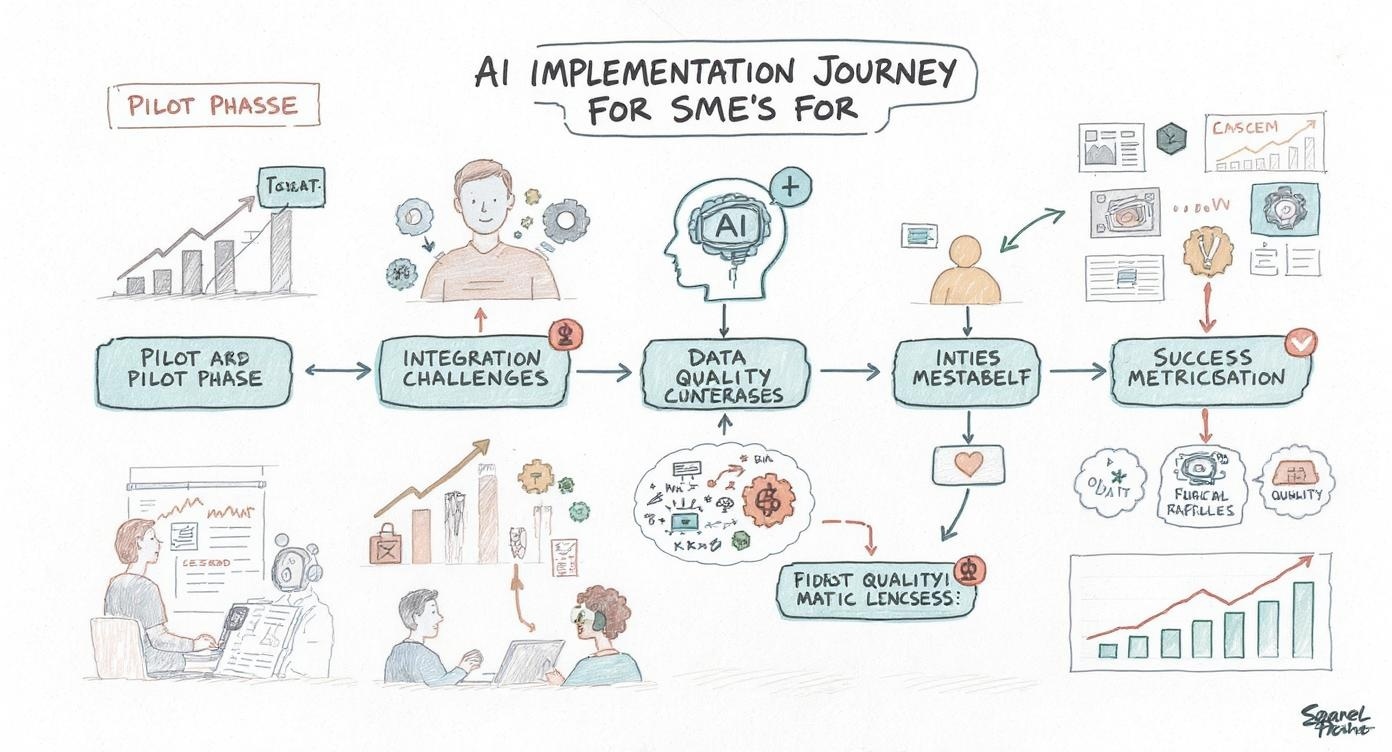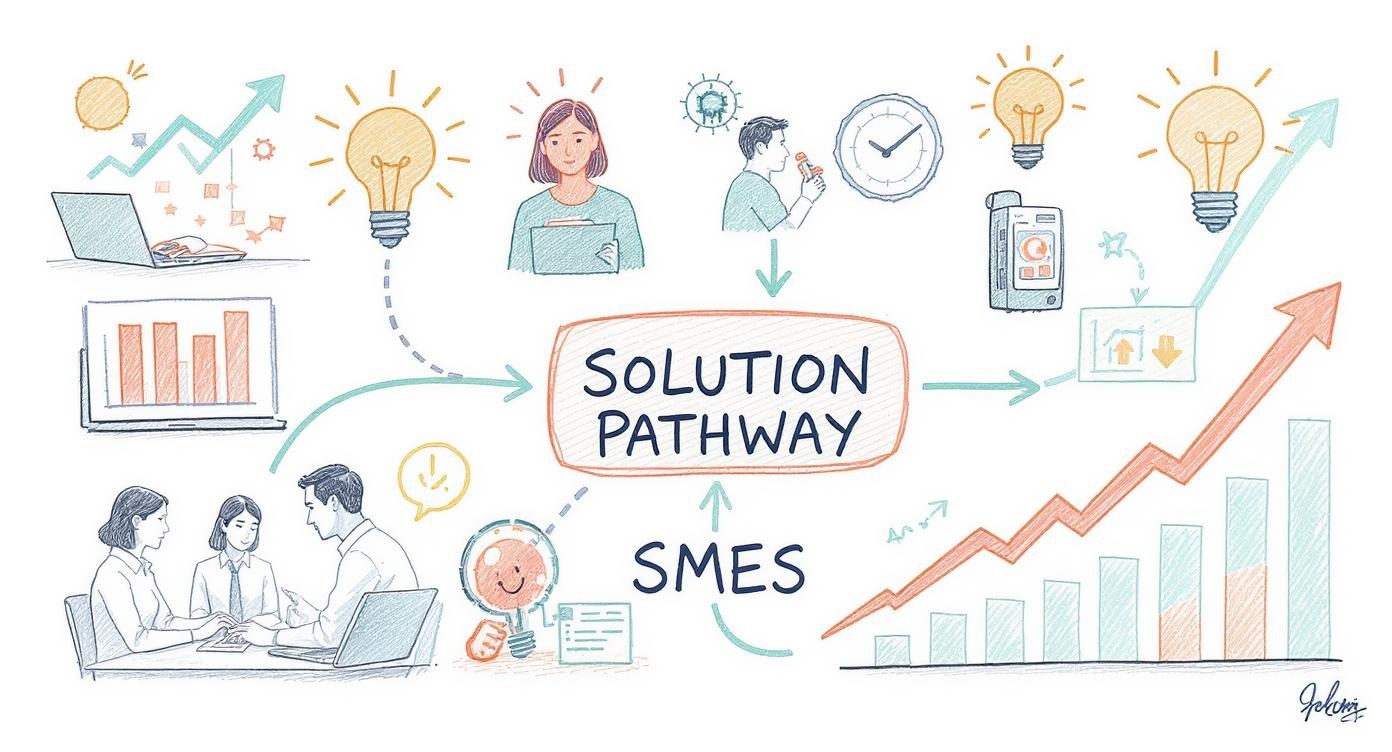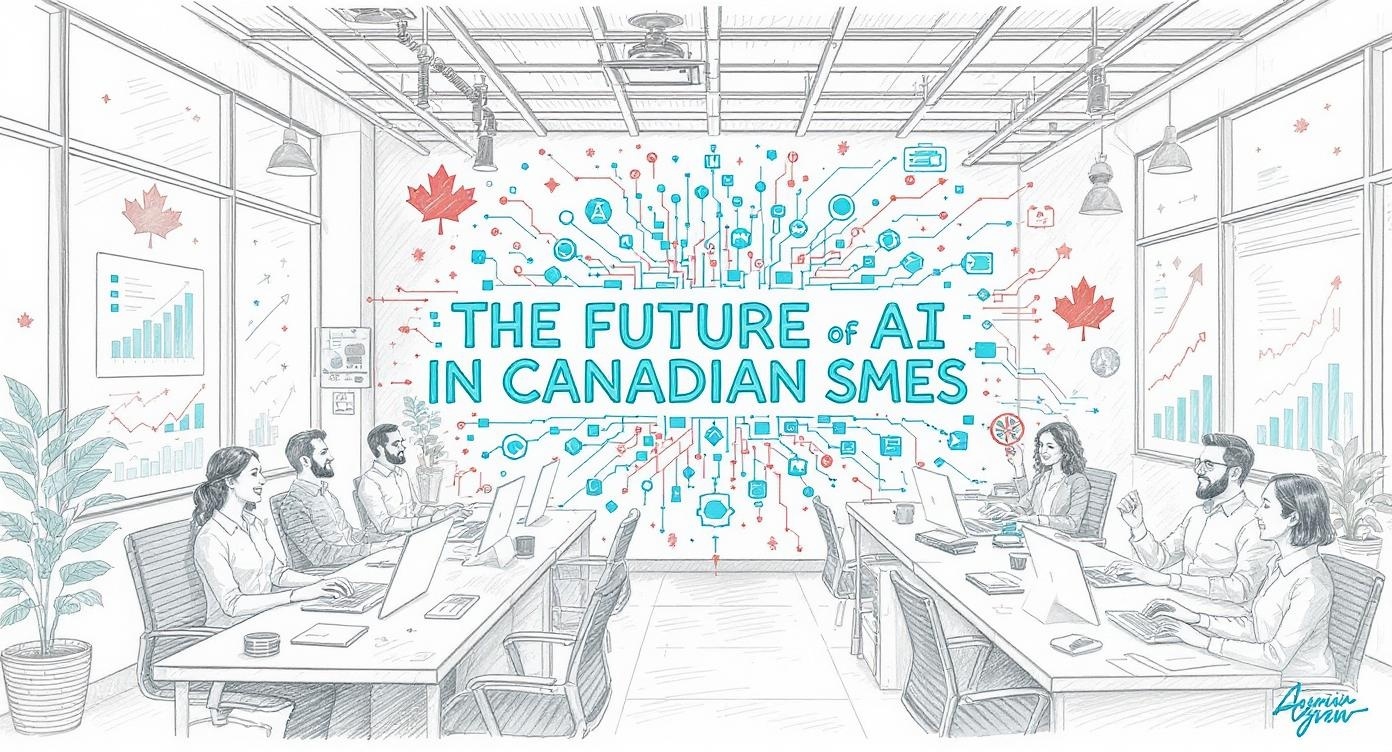The AI Implementation Paradox: Why 91% of Canadian SMEs Adopt AI But 92% Face Major Challenges

The modern Canadian SME faces an unprecedented paradox: widespread AI adoption coupled with significant implementation challenges
In the bustling corridors of Canadian small and medium enterprises, a fascinating paradox is unfolding. While an unprecedented 91% of Canadian SMEs have embraced generative AI in their business operations—a remarkable jump from 77% just one year ago—an equally staggering 92% encounter significant challenges during implementation. This isn’t just a statistic; it’s a wake-up call that reveals the complex reality of AI adoption in today’s competitive business landscape.
The 2025 RSM Middle Market AI Survey¹ paints a picture that many Canadian business owners will recognize: the promise of AI is undeniable, but the path to successful implementation is fraught with unexpected obstacles. From data quality nightmares to security concerns and skill gaps that seem impossible to bridge, SMEs across Canada are learning that adopting AI is just the beginning of a much more complex journey.
Canadian SME AI Reality Check
But here’s what makes this story particularly compelling: despite these challenges, successful AI implementation is not just possible—it’s profitable. Organizations that navigate these obstacles successfully report an average return of $3.70 for every dollar invested in generative AI². The question isn’t whether Canadian SMEs should pursue AI; it’s how they can overcome the implementation paradox that’s holding so many back.
The Great Canadian AI Adoption Surge: Understanding the Numbers
To understand the current paradox, we need to examine the remarkable growth trajectory that brought us here. The Canadian AI adoption story is one of rapid acceleration, driven by necessity, opportunity, and perhaps a touch of competitive fear.

The dramatic rise in Canadian SME AI adoption has created both unprecedented opportunities and unforeseen challenges
The Acceleration Timeline
The numbers tell a story of unprecedented technological adoption. In just 12 months, Canadian SME adoption of generative AI jumped from 77% to 91%—a 14-percentage-point increase that represents hundreds of thousands of businesses diving into AI-powered solutions. This acceleration rivals some of the fastest technology adoptions in business history, comparable to the early days of email or mobile computing.
Statistics Canada’s latest analysis reveals that while only 6.1% of Canadian businesses reported using AI in producing goods and delivering services as of 2024³, this figure dramatically underrepresents the current reality. The discrepancy highlights the challenge of measuring a rapidly evolving technological landscape where adoption often outpaces official reporting.
Industry-Specific AI Adoption Rates in Canada
The adoption surge isn’t uniform across industries. Leading the charge are information and cultural industries at 20.9%, followed by professional, scientific, and technical services at 13.7%, and finance and insurance at 10.9%. Meanwhile, traditional sectors like agriculture (0.7%) and accommodation and food services (0.9%) lag significantly behind⁴.
“The adoption rates we’re seeing prove that AI is no longer a luxury, but a necessity for middle market firms to remain competitive. While 88% of those using generative AI said it has impacted their organization more positively than expected, the 92% challenge rate demonstrates how complex the integration process truly is.”
— Sergio de la Fe, Enterprise Digital Leader and Partner, RSM Canada
What’s Driving the Adoption Frenzy?
Several factors are fueling this rapid adoption:
Competitive Pressure
With 91% adoption rates, not having AI is increasingly seen as a competitive disadvantage
Accessibility
Tools like ChatGPT, Microsoft Copilot, and other AI platforms have made advanced capabilities available to businesses of all sizes
Proven ROI
Early adopters sharing success stories of productivity gains and cost savings
Economic Pressure
Rising costs and tight margins push SMEs to seek efficiency gains wherever possible
The Implementation Challenge: Why 92% Struggle
The high challenge rate among Canadian SMEs isn’t a reflection of AI’s limitations—it’s a mirror reflecting the complex realities of business transformation. Understanding these challenges is the first step toward overcoming them.
The Top Implementation Roadblocks
Data Quality Issues (41% of respondents)
Poor data quality emerges as the number one challenge. Many SMEs discover their data isn’t “AI-ready”—it’s incomplete, inconsistent, or stored in incompatible formats. Unlike larger enterprises with dedicated data teams, SMEs often lack the infrastructure and expertise to clean and prepare their data for AI applications.
Privacy and Security Concerns (39% of respondents)
Canadian privacy regulations, including PIPEDA and provincial legislation, create complex compliance requirements. SMEs worry about data breaches, unauthorized access, and regulatory violations. The fear is often compounded by limited cybersecurity expertise and budget constraints.
Insufficient Internal Skills (35% of respondents)
The AI skills gap is particularly acute for SMEs. Unlike large corporations that can hire AI specialists, small businesses must rely on existing staff to learn new technologies. This creates a chicken-and-egg problem: implementing AI requires skills, but developing those skills requires hands-on experience.

The AI implementation journey reveals critical decision points where SMEs often encounter unexpected obstacles
The Canadian Context: Unique Challenges North of the Border
Canadian SMEs face additional challenges that their American counterparts don’t encounter to the same degree. The RSM survey reveals telling differences:
Canada vs. US SME AI Readiness Comparison
🇨🇦 Canadian Challenges
- • 75% feel unprepared for AI adoption
- • 37% report negative AI consequences
- • Complex regulatory compliance requirements
- • Smaller talent pool for AI expertise
🇺🇸 US Comparison
- • 61% feel unprepared for AI adoption
- • 29% report negative AI consequences
- • More established AI consulting market
- • Larger pool of AI professionals
The Hidden Costs of Failed Implementation
The 92% challenge rate isn’t just about technical difficulties—it represents real business costs. Failed AI projects consume resources, demoralize teams, and can set companies back months or years in their digital transformation journey. Common hidden costs include:
- Wasted licensing fees for unused AI tools
- Employee time spent on ineffective training programs
- Lost productivity during transition periods
- Opportunity costs of delayed competitive advantages
- Reputation damage from AI-powered customer service failures
Success Stories: The 8% Who Get It Right
While 92% face challenges, it’s crucial to understand what the successful 8% do differently. These companies don’t avoid challenges entirely—they approach them strategically and learn to navigate them effectively.
Common Success Patterns
Strategic Approach Over Technical Focus
Successful companies begin with clear business objectives rather than cool technology. They ask “What problem are we solving?” before “What AI tool should we use?” This strategic foundation guides decision-making throughout the implementation process.
Pilot-First Methodology
Rather than company-wide rollouts, successful SMEs start with small, contained pilot projects. These pilots serve as learning laboratories where teams can develop expertise, identify issues, and refine processes before scaling up.
Investment in People
The most successful implementations prioritize human development alongside technology deployment. This includes formal training, mentoring programs, and creating AI champions within the organization.
Most Successful AI Applications for Canadian SMEs
Measuring Success: Beyond the Numbers
Successful SMEs don’t just measure ROI in dollars—they track multiple success metrics:
Time Savings
50% report streamlined IT projects, 45% cite time savings in data analytics
Employee Satisfaction
Teams freed from repetitive tasks focus on higher-value work
Customer Experience
39% report improved customer service processes
Competitive Advantage
Faster response times and improved service quality
The ROI Reality: Understanding AI’s True Value
Despite implementation challenges, the economic case for AI remains compelling. The key is understanding how to measure and capture value effectively.
AI Value Creation Metrics
Beyond Direct ROI: Strategic Value Creation
The most successful Canadian SMEs recognize that AI’s value extends beyond immediate cost savings. Strategic value creation includes:
Market Differentiation
AI-powered services that competitors can’t match
Scalability
Ability to handle growth without proportional staff increases
Innovation Capacity
Freed resources enable focus on strategic initiatives
Risk Mitigation
Better data analysis improves decision-making and reduces business risks
“AI works best when complementing human ingenuity. Companies must upskill their workforce and implement rigorous oversight and AI governance measures to fully capitalize on AI’s potential while mitigating risks.”
— Rhys Morgan, Consulting Partner and North American CIO Services Lead, RSM Canada
Overcoming the Implementation Paradox: A Strategic Roadmap
Success in AI implementation isn’t about avoiding challenges—it’s about anticipating and systematically addressing them. Based on analysis of successful Canadian SME implementations, here’s a strategic roadmap for overcoming the implementation paradox.

Successful AI implementation requires a collaborative approach combining strategic planning, team development, and iterative improvement
Phase 1 Foundation Building (Weeks 1-4)
Strategic Assessment
- • Conduct honest evaluation of current digital maturity
- • Identify specific business problems AI could solve
- • Assess existing data quality and accessibility
- • Evaluate team skills and training needs
Stakeholder Alignment
- • Build leadership consensus on AI objectives
- • Establish clear success metrics and timelines
- • Create communication plan for company-wide buy-in
- • Allocate appropriate budget and resources
Phase 2 Pilot Implementation (Weeks 5-12)
The pilot phase is where most SMEs either build momentum or encounter their first major obstacles. Success requires careful project selection and realistic expectations.
Project Selection Criteria
- Clear Value Proposition: Quantifiable benefits that justify the investment
- Manageable Scope: Contained projects that won’t disrupt core operations
- Data Availability: Sufficient, quality data to train and test AI models
- Stakeholder Support: Champions who will advocate for the project
Common Pilot Project Types
- Customer Service Chatbots: Automating routine inquiries
- Content Generation: Creating marketing materials and documentation
- Data Analysis: Automated reporting and insight generation
- Process Automation: Streamlining repetitive administrative tasks
Phase 3 Scaling and Optimization (Weeks 13-26)
The scaling phase separates successful implementations from failed experiments. This is where the strategic foundation and pilot learnings pay dividends.
Scaling Best Practices
- • Document lessons learned from pilot projects
- • Develop standard operating procedures for AI tools
- • Create training programs for broader team adoption
- • Implement governance frameworks for responsible AI use
- • Establish continuous improvement processes
- • Scale successful pilots to enterprise-wide deployment
Addressing the Big Three Challenges
Data Quality Solutions (41% Challenge Rate)
- Data Audit: Comprehensive assessment of existing data assets
- Cleaning Protocols: Systematic processes for data standardization
- Quality Monitoring: Ongoing systems to maintain data integrity
- Integration Planning: Strategies for connecting disparate data sources
Security and Privacy Framework (39% Challenge Rate)
- Privacy Impact Assessments: Systematic evaluation of data handling practices
- Compliance Mapping: Understanding applicable regulations and requirements
- Access Controls: Implementing appropriate user permissions and monitoring
- Incident Response: Preparing for potential security breaches or data issues
Skills Development Strategy (35% Challenge Rate)
- AI Literacy Programs: Basic AI understanding for all employees
- Power User Training: Advanced training for key team members
- External Partnerships: Leveraging consulting services and educational institutions
- Continuous Learning: Ongoing education as AI technologies evolve
Industry-Specific Implementation Strategies
While general principles apply across sectors, successful AI implementation often requires industry-specific approaches. Here’s how different Canadian SME sectors can optimize their AI strategies.
Professional Services (13.7% adoption rate)
Professional services firms lead SME adoption but face unique challenges around client confidentiality and service quality.
- Document Automation: AI-powered contract review and legal document generation
- Research Enhancement: Automated research and analysis for client projects
- Client Communication: AI-assisted proposal writing and client reporting
- Compliance: Navigating professional responsibility and client confidentiality requirements
Manufacturing and Distribution (6.5% adoption rate)
Traditional industries offer significant AI opportunities but require careful integration with existing systems.
- Predictive Maintenance: AI-powered equipment monitoring and failure prediction
- Supply Chain Optimization: Demand forecasting and inventory management
- Quality Control: Automated inspection and defect detection
- Safety Enhancement: AI-powered safety monitoring and incident prevention
Retail and E-commerce (4.2% adoption rate)
Customer-facing industries can leverage AI for competitive advantage in customer experience.
- Personalization: AI-driven product recommendations and targeted marketing
- Inventory Management: Predictive analytics for stock optimization
- Customer Service: AI chatbots and virtual shopping assistants
- Price Optimization: Dynamic pricing based on demand and competition
The Future Landscape: What’s Next for Canadian SMEs
As we look beyond the current implementation paradox, several trends are emerging that will shape the future of AI adoption among Canadian SMEs.

The future promises transformative AI integration that enhances human capabilities while driving unprecedented business growth
Emerging Trends and Opportunities
AI Agents and Automation
The next wave will bring more sophisticated AI agents capable of handling complex, multi-step business processes
Sustainable AI
Energy-efficient AI models and green computing practices will become competitive advantages
Edge AI Computing
Local AI processing will reduce costs and improve privacy for SME applications
Regulatory Maturity
Clearer AI governance frameworks will reduce compliance uncertainty for Canadian SMEs
The Path Forward: Key Success Factors
Based on our research and analysis of successful implementations, several factors will determine which Canadian SMEs thrive in the AI-powered economy:
The Five Pillars of AI Success
Strategic Vision
Clear understanding of AI’s role in business objectives
People First
Investment in training and change management
Data Excellence
High-quality, accessible data infrastructure
Iterative Approach
Continuous learning and optimization
Partnership Mindset
Leveraging external expertise when needed
Actionable Recommendations for Canadian SMEs
Based on our comprehensive analysis of the AI implementation paradox, here are specific, actionable recommendations for Canadian SMEs looking to overcome the 92% challenge rate and join the successful 8%.
Immediate Actions (Next 30 Days)
- ✅ Conduct a data quality audit across all business systems
- ✅ Identify 3-5 specific business problems AI could solve
- ✅ Assess current team AI literacy and training needs
- ✅ Research Canadian AI privacy and compliance requirements
- ✅ Create a basic AI budget allocation plan
- ✅ Connect with local AI consulting services
- ✅ Join Canadian SME AI user groups and communities
- ✅ Document current manual processes that could be automated
Short-term Goals (Next 90 Days)
- 🎯 Launch one small-scale AI pilot project
- 🎯 Complete basic AI training for key team members
- 🎯 Establish data governance and security protocols
- 🎯 Create AI implementation success metrics
- 🎯 Build relationships with AI technology vendors
- 🎯 Develop internal AI champion network
- 🎯 Create change management communication plan
- 🎯 Establish budget for scaling successful pilots
Long-term Vision (Next 12 Months)
- 🚀 Scale successful pilots to enterprise-wide deployment
- 🚀 Achieve measurable ROI from AI investments
- 🚀 Develop competitive advantages through AI capabilities
- 🚀 Build comprehensive AI governance framework
- 🚀 Create AI-powered customer experience improvements
- 🚀 Develop internal AI expertise and capabilities
- 🚀 Establish strategic partnerships for AI innovation
- 🚀 Position company as AI leader in industry sector
Ready to Overcome the AI Implementation Paradox?
Don’t let your SME become part of the 92% that struggle with AI implementation. Join our community of successful Canadian business leaders who are transforming their operations with intelligent automation.
Frequently Asked Questions
Why do 92% of Canadian SMEs face AI implementation challenges despite high adoption?
What are the most common AI applications for Canadian SMEs?
How can SMEs overcome AI implementation challenges?
What ROI can SMEs expect from successful AI implementation?
How do Canadian SMEs compare to US SMEs in AI readiness?
Related Articles
Research Log & Sources
1. RSM Canada. (2025). “2025 RSM Middle Market AI Survey.” https://canadiansme.ca/middle-market-firms-rapidly-embracing-generative-ai-but-expertise-gaps-pose-risks-rsm-2025-ai-survey/
2. DataFloq. (2025). “Unlocking Exponential Growth: Strategic Generative AI Adoption for Businesses.” https://datafloq.com/read/unlocking-exponential-growth-strategic-generative-ai-adoption-businesses/
3. Statistics Canada. (2024). “Analysis on artificial intelligence use by businesses in Canada, second quarter of 2024.” https://www150.statcan.gc.ca/n1/pub/11-621-m/11-621-m2024008-eng.htm
4. Hunter Tech. (2025). “Eye-Opening Statistics About AI Adoption in Canada (2025).” https://huntertech.ca/blog/ai-adoption-stats-2025/
5. Law.com Legal Tech News. (2025). “Canada at a Crossroads: Navigating AI’s Legal and Ethical Challenges in a Global Context.” https://www.law.com/legaltechnews/2025/06/10/canada-at-a-crossroads-navigating-ais-legal-and-ethical-challenges-in-a-global-context/
Additional Research Sources:
- • McKinsey & Company. (2025). “AI in the workplace: A report for 2025”
- • Business Data Lab. (2024). “Prompting Productivity: Generative AI Adoption by Canadian Businesses”
- • OECD. (2025). “Economic Surveys: Canada 2025: Raising business sector productivity”
- • PwC. (2025). “2025 AI Business Predictions”
- • Macdonald-Laurier Institute. (2025). “Unleashing AI: Canada’s blueprint for productivity, innovation, and workforce integration”
About Chager
Empowering Canadian SMEs with practical AI insights and proven implementation strategies. Our research-backed content helps business leaders navigate the complex world of artificial intelligence.
Resources
© 2025 Chager. All rights reserved. | Privacy Policy | Terms of Service



Recent Comments